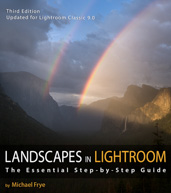In the Moment:
Michael Frye's Landscape Photography Blog
by Michael Frye | Oct 18, 2015 | Yosemite Photo Conditions

Peak and aspens during a clearing storm, June Lake Loop, Friday morning
The past week has been very warm, so there hasn’t been a big color change at the lower elevation aspen groves in the eastern Sierra during that time. But there’s definitely more color in those areas, and some great spots, although much of the June Lake Loop and Lee Vining Canyon are still green. Conway Summit, which is a little higher, has some very colorful groves, although it also has some bare trees, and green ones as well. Several spots in the greater Lee Vining area seem to have more oranges and reds than usual.
We also found some beautiful color in Bishop Creek Canyon. North Lake is past peak, though there was still some nice color along the shore. But lower down we found lots of colorful trees, especially along the road to South Lake.
(more…)
by Michael Frye | Oct 12, 2015 | Yosemite Photo Conditions
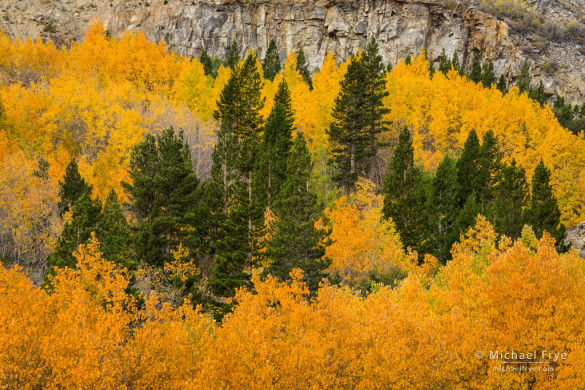
Aspens and lodgepole pines, upper Lee Vining Canyon, yesterday afternoon
After returning from Colorado, and spending a couple of days at home, Claudia and I are back in the eastern Sierra. Yesterday we scouted areas around Lee Vining, and most of the aspen groves here are at about the stage you would expect for the second week of October. That means that the lower-elevation aspens still have a lot of green, and more color can be found in the mid- and high-elevation areas. The best color we saw was in Warren Canyon (in upper Lee Vining Canyon), around Conway Summit (including the lowest part of the road to Virginia Lakes), and Dunderberg. The June Lake Loop and lower Lee Vining Canyon still show a lot of green. We didn’t visit Lundy Canyon yet, but heard there was some nice color there.
We also found some aspen groves that seem to have lost their leaves prematurely. These tend to be in drier areas, so that might a sign of the drought. But these places are a minority, and most of the aspens look healthy and are changing according to their normal schedule.
(more…)
by Michael Frye | Oct 7, 2015 | Announcements, Digital Darkroom
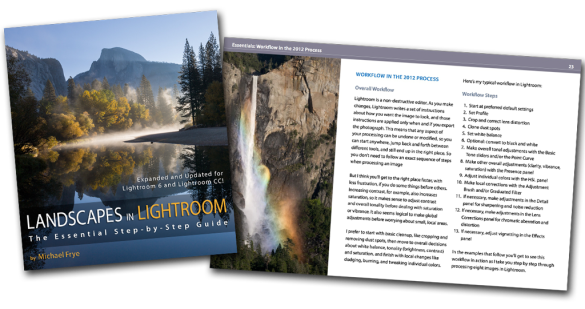
Landscapes in Lightroom: The Essential Step-by-Step Guide
PDF ebook with video tutorials
103 double-page spreads
14.95 for a limited time, after which it goes up to 27.00
FAQ


Here it is! The latest update to my ebook, Landscapes in Lightroom: The Essential Step-by-Step Guide, is now available. This new edition is revised and updated for Lightroom 6 and Lightroom CC, and includes two new examples and videos demonstrating how to use the most significant new features – the HDR Merge and the Panorama Merge.
Of course this new version still has all the features that made the first edition so popular. First, you can download the original Raw files used as examples in the ebook, and then follow along with each step yourself – just as if you were attending one of my workshops.
Second, when you purchase the ebook you get exclusive access to ten videos demonstrating different aspects of Lightroom’s Develop Module, like using the Adjustment Brush, Spot Removal Tool, and Point Curve, advanced retouching in Lightroom, the new HDR Merge, and much more. It’s great to read about a tool or technique; it’s even better to watch a demonstration, and then try it yourself on the same image.
And third, there’s the PDF ebook itself. This includes eight examples, where I take you step-by-step through processing each image in Lightroom. You’ll get to see my workflow in action, with a variety of images – high contrast, low contrast, color, black and white, HDR merge, and panorama. You’ll learn many specific techniques and tips, but perhaps more importantly, you’ll gain insight into the decision-making process that so many photographers struggle with. How much contrast is enough? How far can you push the saturation without making the image look garish or fake? What’s the right white balance?
(more…)
by Michael Frye | Oct 6, 2015 | Travels and Stories
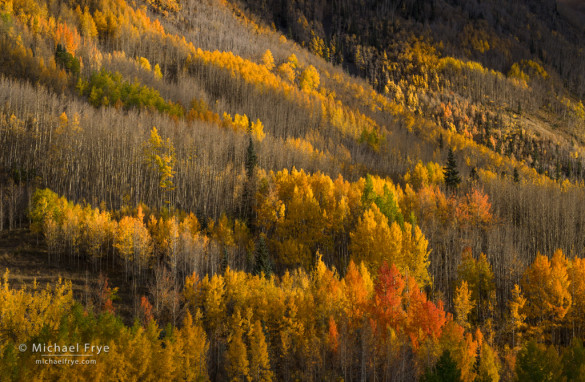
Aspens near Red Mountain Pass, Colorado, USA
We’ve had a wonderful time in Colorado – again. The color hasn’t been as good as last year, but all the locals said that was one of the best autumns they’ve seen. This year the color was shaping up nicely around the San Juan Mountains in the southwestern part of the state, but then last Friday strong winds blew the leaves off many of the aspen leaves. Some areas seem to have received especially strong winds, leaving either bare trees or green ones, and few yellow leaves. But other places weren’t affected much at all, so there were still large swaths of spectacular color.
Here’s a photo from last week near Red Mountain Pass, outside of Ouray. This was made before the wind storm, but this is a high-elevation, early-changing spot, so some of the leaves had already fallen. Sometimes, however, a mixture of colorful leaves and bare trees is more interesting than just a mass of color; in this case the bare patches helped to make the diagonal lines of color stand out and create a pattern.
(more…)
by Michael Frye | Sep 30, 2015 | Travels and Stories
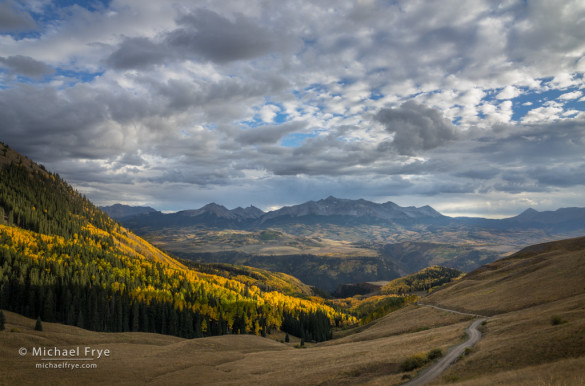
Autumn afternoon in the mountains near Telluride, Colorado, yesterday afternoon
I had planned to go to the Alabama Hills or Death Valley for last Sunday’s lunar eclipse, but high clouds streamed in from the Pacific and threatened to block the view. So at the last minute Claudia and I decided to go further south, toward clear skies that were visible on satellite photos. We ended up in Joshua Tree National Park – along with many, many other people who seemed to think this was a good place to view the eclipse.
They were right of course – it was a great place. And the skies cooperated for the most part. I captured a sequence that I think will work, but I haven’t had a chance to process it yet, because the next morning we started driving to Colorado. We loved our autumn visit last year, and just had to go back. Colorado welcomed us with some nice clouds on our first afternoon; I’ve included one image from that evening above.
(more…)
by Michael Frye | Sep 24, 2015 | Announcements

Curious deer, Yosemite NP, CA, USA
I just sent my prints to the G2 Gallery in Venice, California, for their upcoming exhibit, “Off the Beaten Path: Views From Yosemite.” This looks like a wonderful show, with photographs by Alan Ross, Robin Black, Art Wolfe, Franka Gabler, Ian Shive, Clyde Butcher, Marc Muench, and many others. They chose two of my Yosemite wildlife images for the exhibit, Curious Deer, and Coyote in Snow. The show runs from September 29th to November 15th. Unfortunately I won’t be able to make it to the reception on October 3rd, but I’m sure I’ll be missing a fun event. If you’re in southern California I hope you’ll have a chance to check out the show or attend the reception. You can find more information and see some photographs from the exhibit here.
— Michael Frye
(more…)
by Michael Frye | Sep 22, 2015 | Night Photography, Photography Tips
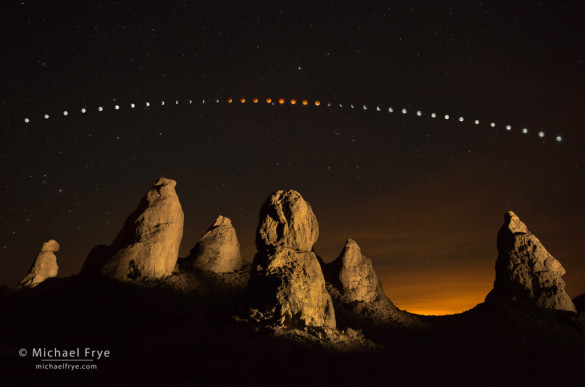
Lunar eclipse sequence, April 14th and 15th, 2014, Trona Pinnacles, CA, USA
We’re going to get another chance to photograph a lunar eclipse this Sunday evening in North America and South America (or early Monday morning in Europe and Africa).
This eclipse also coincides with the moon’s perigee, meaning that the moon will be at its closest point to the earth during its orbit, and will look bigger than usual. The media is going to make a big deal about this “supermoon,” but the moon will only look seven percent larger than average, a difference that won’t be readily apparent to the naked eye, much less in photographs.
However, every total lunar eclipse is special – a spectacular event to view and photograph. And unlike the last one in April, this one will feature a long total eclipse phase.
(more…)
by Michael Frye | Sep 21, 2015 | Yosemite Photo Conditions
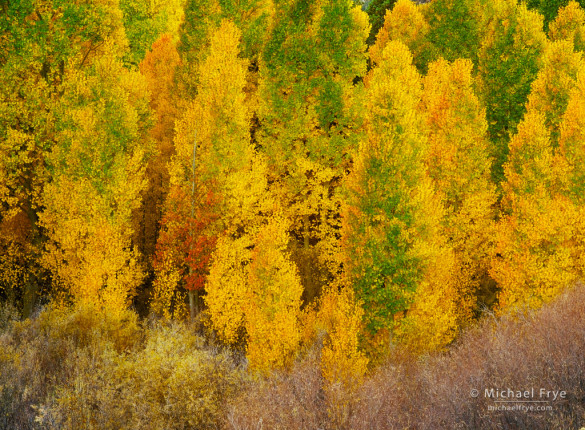
Quaking aspens, Lee Vining Canyon, October 24, 2003
Claudia and I just returned from our annual trip to the Millpond Music Festival and (as Joe Craven puts it) “consciousness-raising event.” We had a wonderful time, as usual. The festival may or may not have raised my consciousness, but it sure was relaxing and fun.
Since the festival takes place in Bishop, on the eastern side of the Sierra Nevada, the trip gives me a chance to check on the early fall color over there. Every year, it seems, some early-changing leaves lead to online predictions that the aspens will turn early. This year I’ve also heard a lot of speculation about the effect the drought will have on the autumn color, and even seen a few actual reports of aspens turning brown and dropping their leaves early.
Driving down to Bishop last Friday, the color didn’t look early at all. There were some yellow and lime-green aspens at the mouth of Warren Canyon (along Highway 120 in upper Lee Vining Canyon), and some lime-green trees on Parker Bench, but everything else looked dark green. Warren Canyon and Parker Bench are both high-elevation, early-changing locations, so that all looked pretty typical for this time of year.
(more…)
by Michael Frye | Sep 16, 2015 | Night Photography
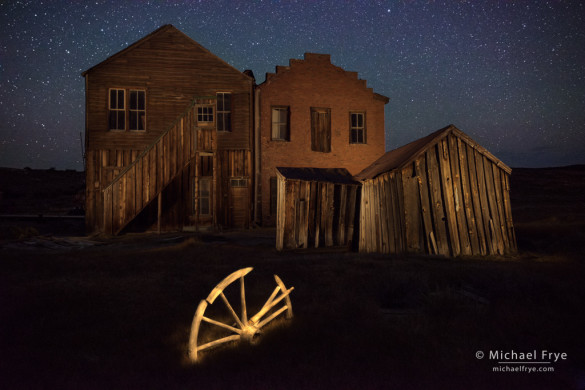
Wagon wheel behind the Dechambeau Hotel, Bodie. I loved this wagon wheel poking out of the ground, and worked with one of our participants, Jeff, to light this scene. We started with an exposure for the sky, then lit the wagon wheel, getting close with a flashlight outfitted with a homemade snoot to try to light only the rim and spokes. Then Jeff lit the shed on the right from two different angles, and I lit the two-story buildings from both sides.
As promised, here are a few photos from the nighttime sessions during our recent Bodie, Inside and Out workshop.
The lighting for each of these photographs was rather complex, and required blending several exposures together. In each case I started with a frame for the sky (my standard pinpoint-star exposure: 15 seconds at f/2.8, 6400 ISO), then used separate frames (at lower ISOs and smaller apertures) to light different aspects of the scene. As I’ve described before, the individual exposures were blended together in Photoshop using the Lighten blending mode, and sometimes adding layer masks to hide stray light.
(more…)
by Michael Frye | Sep 14, 2015 | Workshops
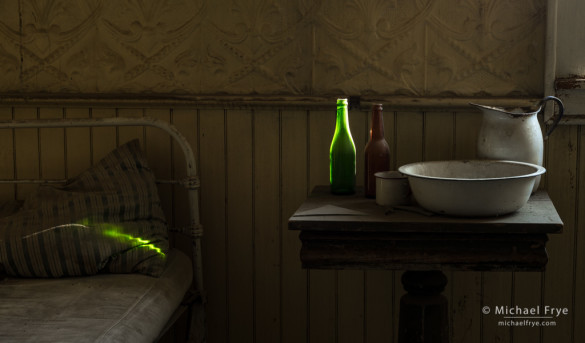
Green light, Wheaton and Hollis Hotel, Bodie State Historic Park, CA, USA
As I said in my last post, we had a great time in Bodie last week. On Tuesday morning we had a permit to photograph inside some of the buildings – a rare opportunity. These interiors are in a lovely state of decay, and it seemed there were wonderful compositions everywhere you looked. We had six hours, but could easily have doubled that without running out of subjects.
You have to be very careful inside the buildings. Everything is coated with a thick layer of dust, accumulated over decades, and even accidentally brushing up against a table with a jacket could mar that dust. These interiors are a museum – a dusty, decaying museum – and being inside the buildings is like being inside the exhibits.
(more…)



















